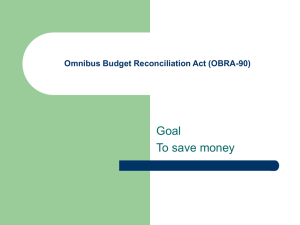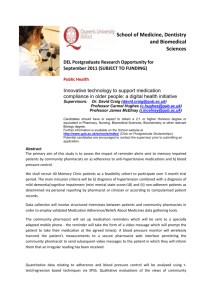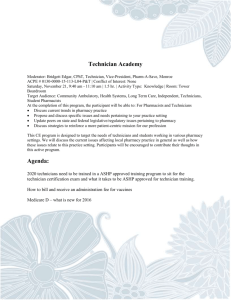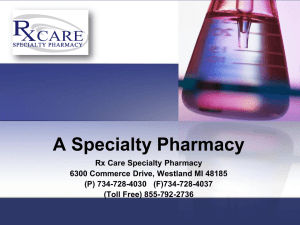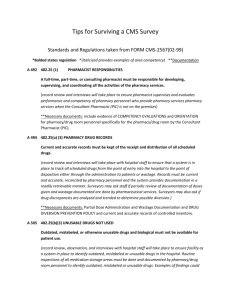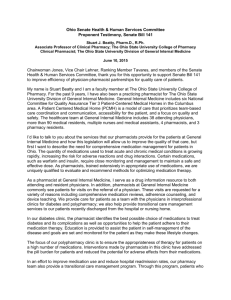Business Case - VA Emergency Department
advertisement
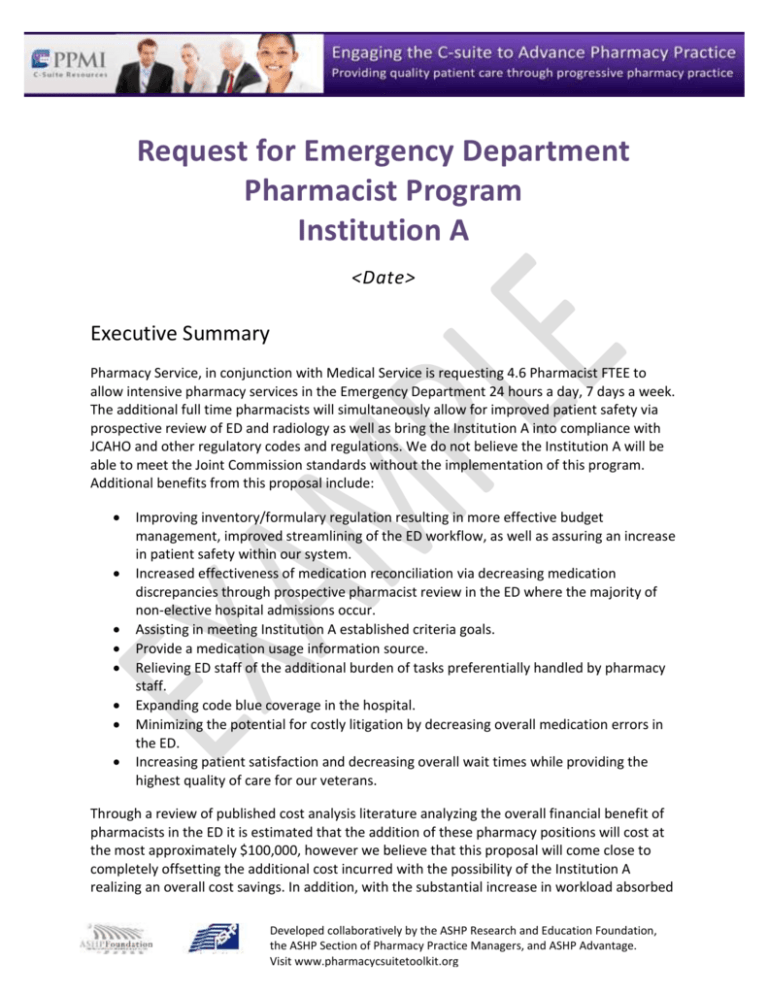
Request for Emergency Department Pharmacist Program Institution A <Date> Executive Summary Pharmacy Service, in conjunction with Medical Service is requesting 4.6 Pharmacist FTEE to allow intensive pharmacy services in the Emergency Department 24 hours a day, 7 days a week. The additional full time pharmacists will simultaneously allow for improved patient safety via prospective review of ED and radiology as well as bring the Institution A into compliance with JCAHO and other regulatory codes and regulations. We do not believe the Institution A will be able to meet the Joint Commission standards without the implementation of this program. Additional benefits from this proposal include: Improving inventory/formulary regulation resulting in more effective budget management, improved streamlining of the ED workflow, as well as assuring an increase in patient safety within our system. Increased effectiveness of medication reconciliation via decreasing medication discrepancies through prospective pharmacist review in the ED where the majority of non-elective hospital admissions occur. Assisting in meeting Institution A established criteria goals. Provide a medication usage information source. Relieving ED staff of the additional burden of tasks preferentially handled by pharmacy staff. Expanding code blue coverage in the hospital. Minimizing the potential for costly litigation by decreasing overall medication errors in the ED. Increasing patient satisfaction and decreasing overall wait times while providing the highest quality of care for our veterans. Through a review of published cost analysis literature analyzing the overall financial benefit of pharmacists in the ED it is estimated that the addition of these pharmacy positions will cost at the most approximately $100,000, however we believe that this proposal will come close to completely offsetting the additional cost incurred with the possibility of the Institution A realizing an overall cost savings. In addition, with the substantial increase in workload absorbed Developed collaboratively by the ASHP Research and Education Foundation, the ASHP Section of Pharmacy Practice Managers, and ASHP Advantage. Visit www.pharmacycsuitetoolkit.org 1 over the past several years without a compensatory increase in staffing, undertaking such a sizeable workload without additional FTEE would not be feasible. ESTIMATED COSTS 4.6 FTEE @ $104,000/FTEE annually Benefits (estimated at 30%) ESTIMATED SAVINGS Savings range (see section II) Probable financial impact on Facility $478,400 $143,520 $586,500-863,800 (-$35,420) – 241,880 I. Background Pharmacy Service, with cooperation, support and input from the Emergency Department (ED), is requesting 4.6 Pharmacist FTEE to institute a comprehensive ED pharmacist program. Below you will find a thorough analysis and justification detailing the reasons for these positions at the Institution A and the anticipated outcomes of the program. The 4.6 Pharmacists would allow intensive pharmacy services in the Emergency Department 24 hours a day, 7 days a week. This document will demonstrate that we believe we can do this at little net cost to the Institution A while significantly improving patient safety and compliance with Joint Commission and other regulatory requirements. It is not possible for Pharmacy Service to accomplish any of these tasks in any meaningful way without additional FTEE due to the continued increase in Pharmacy workload in all its sections and the resultant relative shortage of current staffing levels. We do not believe the Institution A will be able to meet the Joint Commission standards without the implementation of this program. We are asking that the RMC take action quickly on this request so that we can gain all the advantages of the program for optimizing patient care in the ED. The approval of this proposal is also timely for hiring of qualified pharmacists as a number of potential candidates will be ending their advanced clinical residencies at the end of June. II. Cost Avoidance/Cost Savings Initiatives The following studies evaluated the impact of pharmacy involvement in the ED. Although none of the studies were designed to assign direct mortality data from pharmacy involvement in the ED, they were able to quantify the number of interventions pharmacists made, evaluate which areas the pharmacists had the greatest impact as well as calculate projected total cost savings. In 2002 Lee et al. evaluated 600 pharmacist recommendations at a 344 bed Institution A serving over 220,000 patient visits per year providing care to approximately 25,000 veteran patients. Using Institution A costs, pharmacist recommendations and their clinical and economic outcomes were evaluated. The mean cost avoidance per inpatient recommendation was Developed collaboratively by the ASHP Research and Education Foundation, the ASHP Section of Pharmacy Practice Managers, and ASHP Advantage. Visit www.pharmacycsuitetoolkit.org 2 calculated to be $1,057. The table below indicates the types of interventions and recommendations documented and the associated average cost avoidance (1). Type of Recommendation Probable financial impact on Facility Drug interaction Prevent or manage drug allergy Adjust dose or frequency Untreated diagnosis Prevent or manage adverse drug event Drug not indicated Duplication of therapy Average Cost avoided per recommendation (-$35,420) – $241,880 $1,647 $1,375 $1,188 $1,106 $1,098 $724 $165 A study by Lada et al. looked at pharmacist interventions in a 340- bed, university-affiliated, urban level-I trauma center for adult patients. In 2001, over 84,000 adult patients were seen in the hospital’s 100-bed ED. The ED reported 2,150 interventions in a 4 month period with a mean ± SD of 17.5 ± 1.43 within a 24 hour period. This extrapolates to a total of approximately 6,400 interventions per year. The most common interventions involved provision of drug information, dosage adjustment recommendations, responses to nursing questions, formulary interchanges, and suggestions for the initiation of drug therapy. A breakdown of the pharmacist interventions is shown below. Category Drug information Dosage adjustment Nursing questions Formulary interchanges Suggest initiation of Rx Order clarification Change to alternative Rx Compatibility issues Patient information Change route of administration Discontinue drug therapy Toxicology Allergy notification Drug therapy duplication Drug interaction No. Interventions (n = 2150) 362 353 316 181 180 164 157 143 77 66 58 43 40 8 2 Developed collaboratively by the ASHP Research and Education Foundation, the ASHP Section of Pharmacy Practice Managers, and ASHP Advantage. Visit www.pharmacycsuitetoolkit.org 3 Cost avoidance during the 4 month study period was determined to be $1,029,776. Extrapolated to one year the total yearly cost avoidance totals $3,089,328. (2) It should be noted that the data presented by Lee and Lada were based on Institution A costs and thus provide the most accurate depiction of the impact pharmacy services may have on the Institution A ED. Year 1989 1990 1991 # of interventions 9,700 15,770 15,637 # of saving interventions 1,334 1,464 1,541 Cost savings ($) 31,041.20 54,007.09 93,561.22 Cost savings in 2007 dollars ($) 50,942.36 84,088.67 139,791.59 Ling et al. looked at pharmacist interventions in an ED at a large, urban, teaching institution that treats over 100,000 patients annually. A satellite pharmacy was open for 8 hours daily to support medication distribution, and a clinical pharmacist specialist was available for consultation and code response for an additional 8 hours on weekdays. The study documented 401interventions; the total cost avoidance estimated for these interventions was $192,923. This extrapolates to an annual cost avoidance of $463,015. The acceptance rate of pharmacist interventions by other health care professionals was 89%. The top five interventions captured were 1) switching from a non-formulary to a formulary preferred agent, 2) correcting a subtherapeutic dose or frequency, 3) correcting a supratherapeutic dose or frequency, 4) providing professional services, and 5) documenting allergies. The events most frequently avoided were suboptimal disease management, adverse drug reactions, and drug cost avoidance.(3) Levy conducted a separate study which reported cost savings calculated by pharmacist interventions in an emergency department from 1989-1991. Pharmacists were instructed to document all clinical interventions. The data was then compiled for each year and the results are shown below. While analyzing total cost savings, the study calculated only material costs resulting from medication interchanges and adjunctive equipment. Additional cost benefit resulting from time saving interventions, decreased hospital stay and avoidance of adverse events and interactions was not taken into consideration with this study. This would likely result in a significant underestimation of total cost benefit from having a pharmacist employed in the emergency department. The author cited several examples where pharmacist presence in the emergency department had a positive impact on delivery of patient care in the emergency department via distributional, clinical, and educational services performed. The study concluded that pharmacist presence in the emergency department improved medication ordering, administration, and charting in addition to minimizing medication errors while saving almost $180,000 in medication costs over the three year period (4). In current dollars this represents a Developed collaboratively by the ASHP Research and Education Foundation, the ASHP Section of Pharmacy Practice Managers, and ASHP Advantage. Visit www.pharmacycsuitetoolkit.org 4 $275,000 savings in medication costs independent of the potential improvements that could be made to the present inventory management system. Bates et al. assessed the resource utilization associated with an ADE (adverse drug event). Among the 4,108 admissions to medical and surgical units analyzed, 190 ADEs were documented, 60 of which were preventable. The ADEs were associated with a mean additional length of stay of 2.2 days and an average increase in cost of $2,595 per event. For preventable ADEs the associated increased length of stay was 4.6 days with an increase in cost of $4,685 (5). Senst and colleagues performed a study in which one of the goals was to analyze data from multiple hospital admissions and project costs of ADEs occurring after admission and resulting in admission. Data was collected from a healthcare system comprised of a 383-bed tertiary care facility; a 60-bed Mental Health Center, an 84-bed Children's Psychiatric unit, and a 30-bed facility for children with disabilities. The estimated ADE rate during hospitalization was 4.2 events per 100 admissions, with a cost of $2,162 per ADE. In addition, 3.2% of admissions were caused by ADEs, with an associated cost of $6,685 per event (6). Based on the study, 15% of hospital ADEs and 76% of ADEs causing admission were judged preventable. A retrospective study by Beers et al. sampled 424 randomly selected adults seeking care at a university-affiliated 24 bed hospital ED that sees over 37,000 patients per year. Among patients who received medications at the ED, they found a 10% rate of exposure to what were considered clinically relevant potential ADEs. Upon reviewing patient charts, there was little indication that physicians were aware of the potential for adverse drug reactions (7). Data published by Leape et al., which addressed the pharmacist’s impact at the time of prescribing, showed that the active participation of a pharmacist during clinical ICU rounds was associated with a 66% reduction in ADEs with respect to baseline (from 10.4 to 3.5 ADEs per 1000 patient-days), with no change in the incidence of ADEs being noted in the control group. These outcomes were achieved with a clinical pharmacist being available in the morning on rounds and by consult thereafter (8). Our proposal allows for an onsite pharmacist to participate in all ED admissions around the clock, while also serving to actively process and deliver medications, control medication inventories, and assess progress and outcomes of therapy as part of the ED team. The majority of the studies reviewed implemented programs that provided service support for less than 24 hours, suggesting that our 24 hour program should result in further benefits relative to those reported. Assigning monetary value to the individual patient care contributions made by a healthcare provider is challenging and represents a barrier in accurately determining the true fiscal impact a pharmacist’s contributions may have on a service. Studies addressing the drug-related morbidity costs and drug cost-avoidance are thus important in developing accurate estimations of the dollar value of the ED pharmacist program. A model developed by Ling et al. combined Developed collaboratively by the ASHP Research and Education Foundation, the ASHP Section of Pharmacy Practice Managers, and ASHP Advantage. Visit www.pharmacycsuitetoolkit.org 5 study outcomes from both cost-avoidance and drug-related morbidity studies. Interventions were stratified into 6 levels in an attempt to categorize the impact of each intervention. The table below provides an example of the average cost savings of each type of intervention (3). Unit type Medical ICU Surgical ICU General Medical General Surgical Total avg. Cost per event $3,369 $5,097 $2,738 $1,772 $2,595 Outcomes of ED Interventions by Pharmacists: Adapted from Ling et al Level Cost Avoidance Information inquiry 1a (≤5 min) Information inquiry (>5 min i.e. 1b oral/written presentation) Dosage adjustment, formulary/restricted 2 medication, IV/PO switch, therapeutic duplication Explanation Category Cost ($) Verbal info Drug info 26.17 Verbal info with presentation and/or articles Drug info 54.89 Drug cost avoidance Drug cost avoidance 30.35 3a Additional treatment Medications, aerosolizations, transfusions, oxygen 3b Additional tests Chemistry panels, CBCs, drug concentrations etc. 3c 4a 4b Noninvasive procedure, additional tests Additional treatment and additional tests Noninvasive procedure, additional CT, angiography, ECG, Doppler, EEG, ECHO, MRI, CXR, PFT etc. + 3b 3a+3b 3a + 3c Avoidance of additional treatment Avoidance of additional treatment Avoidance of additional treatment Avoidance of additional treatment Avoidance of additional treatment 260.46 109.00 320.70 370.04 581.75 Developed collaboratively by the ASHP Research and Education Foundation, the ASHP Section of Pharmacy Practice Managers, and ASHP Advantage. Visit www.pharmacycsuitetoolkit.org 6 4c treatment, and additional tests Increased length of stay or admission from med. related problem + 4b Daily room rate + 4b 4d Invasive procedure + 4c Cath, MI perfusion studies, PTCA, surgery, dialysis, pericardiocentesis + 4c 5a Transfer to ICU + 4c ICU bed, art line, Swan-Ganz, intubation, cardiac arrest + 4c 5b 5c 6 Transfer to ICU, invasive procedure + 4c Long term care admission + previous Death Invasive procedures + 5a Self-explanatory Self explanatory Avoidance of additional treatment Avoidance of additional treatment Avoidance of additional treatment Avoidance of additional treatment Avoidance of additional treatment Avoidance of additional treatment 3,562.79 6,437.13 6,592.03 9,466.36 11,837.5 1 100,000 Based on the model above and the cost avoidance data presented by Lada et al. (2) it can be estimated that a pharmacist staffed ED that sees 8-9 acutely ill patients daily will realize savings of $6,428 -$9,465 per 24 hour period relative to an ED that does not employ the service of a clinical pharmacist. The presented range of savings was calculated by multiplying the lower and higher average costs of an individual ADE ($400-500) by the average number of ADEs reported daily +/- the standard deviation (17.5+/- 1.43). The value of an individual ADE was extrapolated from the Ling et al. data. A conservative extrapolation of these numbers to our facility suggests that a more moderate recovery of resources would likely offset the $620,000 invested into salaries (including benefits) for 24 hour ED coverage by a pharmacist. For example, if both the number of patients seen daily and the savings per intervention are reduced by 50%, a savings of $586,500-863,800 is still attainable. This implies that it is beneficial from both a resource investment and patient outcome perspective to implement such a program within the Institution A facility. III. Improved Patient Safety The continuous improvement of patient care is of paramount importance, and with a majority of patients visiting the ED receiving multiple medications, there is significant opportunity for the introduction of medication errors into the system. We currently lack appropriate Developed collaboratively by the ASHP Research and Education Foundation, the ASHP Section of Pharmacy Practice Managers, and ASHP Advantage. Visit www.pharmacycsuitetoolkit.org 7 application of clinical pharmacy in the ED, with administered medications never being screened for compatibility, patient allergies, drug interactions, or dosage. In its present state, the Institution A system does not require medication orders to be placed for agents administered by providers in the ED or in radiology. However, 2006 Joint Commission standards require a review of all hospital orders. This ultimately means that providers in the ED and radiology will be charged with placing orders for all medications administered. This change will also impact the pharmacy service as the new workload associated with an increase in medication order verification duties of the pharmacist will result in a compromise of current resources. Today’s Pharmacist is uniquely equipped to serve as the expert in the therapeutic use of medications while providing direct patient care. Without the proactive application of this expertise, it is not possible to ensure optimal and safe drug therapy for our patients. Data shows that medications are administered or prescribed in almost 80% of ED visits with three or more medications administered or prescribed in about 30% of patient visits (9). At Institution A we estimate this number to be approximately 40%. With such a high amount of medication usage associated with ED encounters, numerous opportunities are available for medication errors to occur. Chin and colleagues performed a prospective cohort study of 898 patients 65 years or older who presented to an urban academic ED in 1995 and 1996. They reported that 3.6% of ED patients were administered an inappropriate medication and 5.6% were prescribed an inappropriate medication upon discharge from the ED. (10) A study by Hafner et al. retrospectively reviewed 13,004 emergency department charts from visits occurring between March 1 and May 31 of 1997. The researchers found 321 (2.5% of all charts) total visits with suspected adverse drug events. Based on the Naranjo adverse drug reaction probability scale, a method used to estimate the probability of adverse drug reactions, 217 visits (1.7% of all charts) had a score greater than 4 and were classified as probable ADEs. Compared with the control population, the patients with ADEs were hospitalized more frequently (OR 2.29; 95% CI 1.33 to 3.94 (11)). Although these studies looked at the overall incidence of medication errors in their respective EDs, they did not address the potential benefit gained through pharmacy involvement. IV. Compliance with Joint Commission Mandates A. EMERGENCY DEPARTMENT ORDER REVIEW Joint Commission Medication Management (MM) Standard 4.10 (MM.4.10) requires that all prescriptions or medication orders be reviewed prospectively for appropriateness by a pharmacist. Our facility currently lacks a system for the review of orders placed in the ED and in radiology, and we are thus failing to meet the minimum criteria for standard 4.10 (12). The addition of an ED pharmacist would satisfy this standard and it would also serve to reduce the likelihood of patient harm from occurring. In a recent case of medication mismanagement, a patient who had presented to the ED with seizures was overdosed on phenytoin, a mistake Developed collaboratively by the ASHP Research and Education Foundation, the ASHP Section of Pharmacy Practice Managers, and ASHP Advantage. Visit www.pharmacycsuitetoolkit.org 8 made by a healthcare provider that has led to a criminal investigation of the involved parties (13). With the reality of practitioners being held accountable for the outcomes of medication errors, it is important that preventative measures be taken in order to protect the patients, providers, and the healthcare system from the legal ramifications of medication misadventures. A prospective verification system would act as a filter and quality assurance tool, preventing medication mistakes such as the one just mentioned from occurring and is a compelling reason to pursue the implementation of such a system. Prospective review ultimately requires allocation of pharmacy staff to the emergency department to assure that the new goals do not delay the administration of pharmaceutical care for all patients and especially to critical patients whose outcomes are time dependent. B. MEDICATION RECONCILIATION 2007 Joint Commission patient safety goals place an emphasis on medication safety, specifically on medication reconciliation practices and safe medication use. Standard MM 3.20 requires that medication reconciliation be completed at each point of transitional care and can be completed by any qualified healthcare provider (12). At the Institution A approximately 90 patients on weekdays and 60 patients on weekends present to the ED, with 15-20% of presenting patients being admitted to the facility. These 9-13 daily ED admissions reflect a majority of our non-elective admissions to the facility. This places a significant burden on the ED, as the ED staff is required to complete the initial medication reconciliation of all patient visits and for patients being admitted. It is clear that the most effective point of reconciliation is at the time of admission, and resources need be allocated for medication reconciliation services in the ED. Studies assessing the effectiveness of the reconciliation process have identified that pharmacists provide the highest level of effective reconciliation, reducing medication omission errors and discrepancies upon admission and assuring that the patient receives the appropriate medications at discharge. Scarsi et al from Northwestern Memorial found that in the absence of pharmacist intervention, 22 percent of medication discrepancies posed potential risk for patient harm during hospitalization, and 60 percent of the discrepancies may have led to deleterious outcomes if continued beyond discharge (14). The most common error was the complete omission of a medication that the patient reported taking prior to hospitalization, as well as reports of a different dose, route or frequency of medication ordered. Many of these medication discrepancies could be eliminated by the concomitant implementation of a prospective medication review and an ED medication reconciliation program, serving to significantly improve our current level of patient care. Developed collaboratively by the ASHP Research and Education Foundation, the ASHP Section of Pharmacy Practice Managers, and ASHP Advantage. Visit www.pharmacycsuitetoolkit.org 9 V. OIG /DEA Compliance, National/VISN Performance Goals and other considerations A. INVENTORY/FORMULARY MANAGEMENT AND SECURITY Medication distribution within the ED is currently carried out through the use of the automated dispensing cabinet (ADC) system, with inventory updates being completed weekly by technicians from the pharmacy service. An audit of the actual versus expected medication counts of floor stock items in the ED ADC system was conducted in March 2007. During this audit, fifteen random medications were counted, recorded, and compared to the expected inventory counts produced from the ADC report for the ED. The results showed inaccurate counts for all agents, including refrigerated and controlled agents, as compared to the expected inventory in the ADC log. It is unclear whether these agents were used in patient care, diverted, disposed of or lost. The pharmacy technicians currently depend on the accuracy of the ADC report to guide them in the restocking process. These discrepancies represent a danger to both our patients and our healthcare system. An inaccurate count could potentially result in an inability to deliver medications in a timely manner to critical patients if floor stocks are unknowingly depleted, and our medical team and facility would be held accountable for deleterious outcomes in such an instance. Moreover, failure to meet DEA and FDA requirements associated with the physical storage, distribution, and documentation of the use of dangerous drugs and controlled substances could result in actions being taken against our facility. Improvements in this system would benefit our organization by reducing the loss of inventory resulting in more effective budget management and will assure both patient safety and security within our system. The expansion of such management would be a component of the described duties for the pharmacist staffing the ED. B. PATIENT SATISFACTION Improving the efficiency of patient care in the ED is important, and as patient wait times increase we often lose the opportunity to serve our patients. In February 2007 there were 184 reports of patients waiting >6 hours to be seen by a provider, and 157 cases where the patient left prior to being assessed. This does not account for the number of patients who fail to receive the prescribed medications from the outpatient pharmacy due to an additional wait beyond the time spent in the ED. The pharmacy wait is often in excess of 30 minutes on weekdays and 2 hours on weekends, the latter being attributed to the fact that weekend ED coverage is carried out by pharmacists staffing the ICU. These wait times have manifested in complaints to patient services as well as verbally expressed dissatisfaction by the veterans of our healthcare system. To address these wait times and thus improve patient care and satisfaction, medication reconciliation, medication processing and medication dispensing duties would be assigned to the pharmacist on staff in the ED. This will help to reduce time to provider Developed collaboratively by the ASHP Research and Education Foundation, the ASHP Section of Pharmacy Practice Managers, and ASHP Advantage. Visit www.pharmacycsuitetoolkit.org 1 0 contact and will expedite the processing and dispensing of prescribed agents. For patients being admitted, this will also improve continuity of care within the pharmacy service, as improved communication of ED management to medicine and ICU pharmacists can be achieved. C. TELEMETRY UNIT The ED will soon be responsible for the management of a telemetry unit. This addition will result in an increase in workload and the use of many drugs unfamiliar to the nursing staff, warranting close monitoring and assessment of ordered agents by the healthcare team. The ED pharmacist will serve to both assess and monitor the patients in this unit, working to ensure safe medication use in this critical population of patients. D. MEETING INSTITUTION A ESTABLISHED CRITERIA Pharmacists staffing the ED will provide an additional resource for meeting goals that have been established and implemented within the INSTITUTION A Healthcare System. Examples of these goals include administration of antibiotics within 4 hours of arrival and obtaining blood cultures prior to antibiotic administration in patients presenting with community acquired pneumonia, appropriate and timely antibiotic utilization, management of prophylactic antibiotic use, time to medication delivery in NSTEMI patients, and tobacco counseling in MI, HF and CAP patients. E. CODE BLUE COVERAGE The ICU pharmacist is currently responsible for responding to code blue calls on all floors in the hospital, including codes called on the first floor. The ED pharmacist’s responsibilities will include responding to codes on the first floor. Hence, the addition of an ED pharmacist will allow the ICU staff to focus on the acute issues in their own area, avoiding the potential interruption of patient care in the ICU and DOU. This will also serve to improve the response time to codes called on the lower floors of the hospital and will reduce time to administration of critical medications supplied by the pharmacist. VI. ACA Principles Pharmacy Service conducts ongoing analysis of its staffing and potential for assuming new responsibilities at Institution A. Currently our staffing in all the sections of pharmacy is highly taxed due to growing workload. Over the past several years we have forestalled additional FTEE for these workload increases by utilizing automation, improving operational efficiency, and increasing the roles of students and residents in patient care areas. One example of such Developed collaboratively by the ASHP Research and Education Foundation, the ASHP Section of Pharmacy Practice Managers, and ASHP Advantage. Visit www.pharmacycsuitetoolkit.org 1 1 workload growth is the Ambulatory Care Pharmacy as demonstrated by the prescription volume changes over the past 10 years. Nearly all of this has been accomplished without additional FTEE to this section. Although we are happy with our successes thus far, we are unable to take on such a huge additional program such as the ED pharmacist program without additional FTEE. Developed collaboratively by the ASHP Research and Education Foundation, the ASHP Section of Pharmacy Practice Managers, and ASHP Advantage. Visit www.pharmacycsuitetoolkit.org 1 2 VII. Summary Pharmacy Service believes that with an additional 4.6 Pharmacist FTEE we can attain a myriad of successes in the areas of improved patient care and regulatory compliance. Because of the demonstrated cost savings, the new cost to the facility will be, at most, approximately $100,000, but we believe this program will most likely be a breakeven, or optimistically, a cost savings proposition. These positions would represent a new commitment to our goal for the highest quality of care for our veterans, while minimizing the financial impact on the Institution A. VIII. References 1) Lee AJ, Boro MS, Knapp KK, Meier JL, Korman NE. Clinical and economic outcomes of pharmacist recommendations in a Veterans Affairs medical center. Am J Health Syst Pharm. 2002 Nov 1;59(21):2070-7. 2) Lada P, Delgado G Jr., Documentation of pharmacists' interventions in an emergency department and associated cost avoidance. Am J Health Syst Pharm. 2007 Jan 1;64(1):638. 3) Ling JM, Mike LA, Rubin J, Abraham P, Howe A, Patka J, Vigliotti D. Documentation of pharmacist interventions in the emergency department. Am J Health Syst Pharm. 2005 Sep 1;62(17):1793-7. 4) Levy DB. Documentation of clinical and cost-saving pharmacy interventions in the emergency room. Hosp Pharm. 1993 Jul; 28(7):624-7, 630-4, 653. 5) Bates DW, Spell N, Cullen DJ et al. The costs of adverse drug events in hospitalized patients. Adverse Drug Events Prevention Study Group. JAMA. 1997 Jan 2229;277(4):307-11. 6) Senst BL, Achusim LE, Genest RP et al. Practical approach to determining costs and frequency of adverse drug events in a health care network. American Journal of Health-System Pharmacy. 2001 June; 58(12):1126-1132. 7) Beers MH, Storrie M, Lee G. Potential adverse drug interactions in the emergency room. An issue in the quality of care. Ann Intern Med. 1990 Jan 1;112(1):61-4. 8) Leape LL, Cullen DJ, Clapp MD, Burdick E, Demonaco HJ, Erickson JI, Bates DW. Pharmacist participation on physician rounds and adverse drug events in the intensive care unit. JAMA. 1999 Jul 21;282(3):267-70. Erratum: JAMA 2000 Mar 8;283(10):1293. Developed collaboratively by the ASHP Research and Education Foundation, the ASHP Section of Pharmacy Practice Managers, and ASHP Advantage. Visit www.pharmacycsuitetoolkit.org 1 3 9) McCaig, Linda F. "National Hospital Ambulatory Medical Care Survey: 2004 Emergency Department Summary." Advanced Data from Vital and Health Statistics 372(2006): http://www.cdc.gov/nchs/data/ad/ad372.pdf 10) Chin MH, Wang LC, Jin L et al. Appropriateness of medication selection for older persons in an urban academic emergency department. Acad Emerg Med. 1999; 6:1232-42. 11) Hafner JW Jr, Belknap SM, Squillante MD, Bucheit KA. Adverse drug events in emergency department patients. Ann Emerg Med. 2002 Mar;39(3):258-67. 12) http://www.jointcommission.org/PatientSafety/NationalPatientSafetyGoals/07_hap_ cah_npsgs.htm 13) Criminal Prosecution of human Error Will Likely Have Dangerous Long-term Consequences. ISMP Medication Safety Alert. 2007 March; 12(5): 1-2. 14) Scarsi KK, Fotis MA, Noskin, GA. Pharmacist participation in medical rounds reduces medication errors. AJHSP. 2002 Nov; 59(21):2089-2092. Developed collaboratively by the ASHP Research and Education Foundation, the ASHP Section of Pharmacy Practice Managers, and ASHP Advantage. Visit www.pharmacycsuitetoolkit.org 1 4
